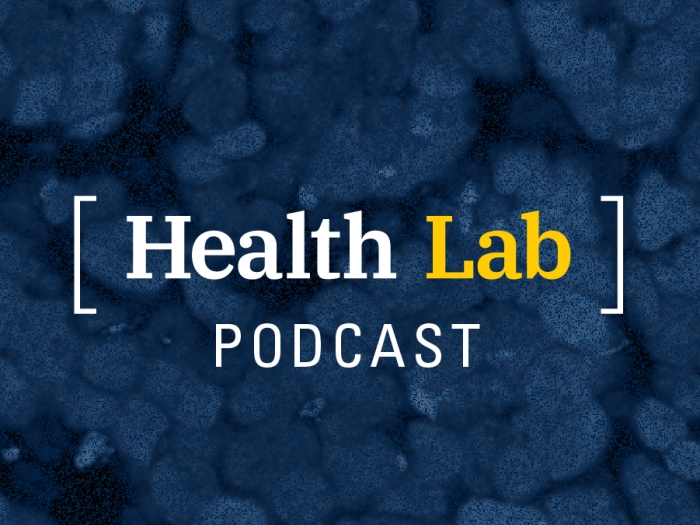What school staff should know about seizure first aid
For kids with epilepsy, seizures can strike at any time. Here’s what you can do to help.
More resources
Transcript
Host:
Welcome to Health Lab, your destination for news and stories about the future of healthcare. Today: The 3 S’s of seizure first aid. For kids with epilepsy, seizures can strike at any time. Here’s what you can do to help.
Seizures, a sudden surge of electrical activity in the brain, can impact thinking, muscle control, movement, speech, vision or awareness.
Although brief, seizures can frighten patients and those surrounding them, especially if they’re unfamiliar with what steps to take when a seizure occurs.
“In Michigan, we have 13,600 children living with epilepsy, a disorder that causes recurring seizures that can happen out of the blue,” said Sarah Dixon, M.D., a pediatric neurologist at University of Michigan Health C.S. Mott Children’s Hospital.
Despite its prevalence, there is currently no structured training about epilepsy and seizures for school personnel or volunteers in Michigan.
“There are over 4,200 students per one school nurse in Michigan. Relying on school nurses to help all the children who are living with epilepsy is an unrealistic expectation,” said Dixon.
Training more school personnel and volunteers on seizure first aid can help alleviate this burden and allow those in the school environment to be more prepared should a seizure occur.
How to identify a seizure
Seizures look different for every person who has epilepsy.
Most often, people envision seizures as when someone’s body becomes stiff and starts to make involuntary jerking movements.
But there are many other seizure types, says Dixon.
Sometimes, people experience stiffening and jerking movements on one side of the body, while they’re still conscious and aware of their surroundings.
Some people may stare off into space and be unresponsive during their seizure.
Others describe a funny feeling in their body or stomach, experience déjà vu or detect a certain smell before their seizure starts.
“Because there’s a broad range of what a seizure can look like, it is important that kids have a seizure action plan. This describes what their typical seizures look like, when to give rescue medication, and when to call 911,” said Dixon.
Seizure first aid
When administering seizure first aid, follow the three S’s: Stay, Safe, Side. The procedure remains the same when helping people of any age who are experiencing a seizure.
1. Stay – Remain with the person for the duration of the seizure.
Try to remain calm and check if they have a medical ID which indicates an epilepsy diagnosis and important treatment information.
Start a timer when the seizure begins. Some seizures last seconds while others may be minutes long.
A seizure lasting five minutes or longer is considered a potentially life-threatening emergency.
2. Safe – Remove the person from any potentially hazardous situations to prevent injury. Remove any harmful or sharp objects nearby.
If the person has not lost consciousness, but is wandering or confused, help steer them clear of dangerous situations such as traffic if they’re walking close to a road or heights if they’re near a place they could fall.
If a seizure occurs in the tub or pool, remove the person from the water.
3. Side – If the person loses consciousness, lay them on the ground and put them on their side with their mouth pointing toward the ground.
This prevents saliva from blocking the airway and allows them to breathe more easily.
Seizure don’ts
Do not place anything in the person’s mouth. Putting something in the person’s mouth could block their airway. The jaw can tighten strongly during seizures which could cause them to break the item and chip a tooth or choke.
Do not restrain the person. Trying to forcibly hold someone down is not going to stop the seizure from happening and it could potentially lead to injuries.
When to call 911
“If you’re ever questioning whether to call 911 when administering seizure first aid, call. No one will fault you for getting help in a situation where you're not sure what to do,” said Dixon.
There are specific situations when you should immediately call 911:
If a seizure lasts five minutes or longer
If a person has one seizure back to back without regaining consciousness between seizures
If the person is having trouble breathing or appears to be choking
If there’s a risk they aspirated water
If this is the first time that person has ever had a seizurere
“One in 26 people will develop epilepsy at some point in their lifetime – more commonly in childhood or as an older adult,” said Dixon.
“Knowing that epilepsy is more common in children, it makes sense to ensure our school personnel and volunteers are educated and prepared to respond to a seizure until emergency medical help arrives,” said Dixon.
The Epilepsy Foundation is a great resource to bring seizure education to communities.
They offer free seizure first aid training programs where they educate participants about how to recognize and respond to seizures.
“I'm particularly passionate about increasing seizure first aid training to make sure our patients who have epilepsy are supported as best as they can be in our community and especially in the school environment,” said Dixon.
Educational resources for epilepsy and seizures are included below and in the show notes for this episode:
Epilepsy Foundation Training and Education
Michigan Medicine Comprehensive Pediatric Epilepsy Care
For more on this story and others like it, visit michiganmedicine.org/health-lab. Health Lab is a part of the Michigan Medicine Podcast Network and is produced by the Michigan Medicine Department of Communication. You can subscribe to Health Lab wherever you listen to podcasts.

Listen to more Health Lab podcasts - a part of the Michigan Medicine Podcast Network.





